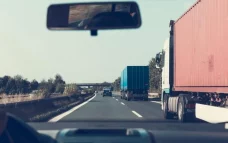The House Roads and Transportation Committee met earlier this week to discuss House Bill 1022. This bill would prevent automated tractor trailers from being used on a highway to transport passengers or goods unless a human operator meeting state and federal qualifications were present.Â
In Indiana, according to Lee Cossell & Feagley, attorneys at law, all semi truck operators must have a Class-A CDL, or commercial drivers license, and it must be renewed every four years. In addition, they must complete vision, skills and vehicle inspection tests.
On Tuesday, lawmakers discussed concerns regarding the safety and functionality of autonomous vehicles.Â
“Autonomous vehicles are known to struggle with seemingly common tasks such as taking on or off ramps and turning left in the face of oncoming traffic,” said Rep. Cindy Ledbetter, R-Newburgh, author of the bill.
Members of the public also testified and shared stories, including some truck drivers from around the state.Â
Jay Jackson, executive director of ABATE (American Bikers Aimed Towards Education) of Indiana in Bargersville, shared his concern with the ability of autonomous vehicles to recognize motorcycles.Â
“There are a number of cases that point to some premature launches with regards to autonomous vehicle technology specific to motorcycles. There was an eight-month period where Tesla was involved in three fatal motorcycle collisions in autopilot,†said Jackson.
Jackson said he believes the technology is 90% effective at recognizing motorcycles, pedestrians and cyclists, but he’s concerned about the 10% that don’t get recognized. He said he looks forward to the day when driverless trucks are proven effective, but for now, he said, it’s very dangerous for motorcycles.Â
“Obviously we hope for the day when driver error is removed by such wonderful technology, but today is not the day,†Jackson said.
Jerod Warnock, vice president of Teamsters Local 364 and the Indiana State Building and Construction Trades Council, testified next.Â
“Driverless vehicles are not what we need to maintain the safety of our families. Story after story, and Mr. Jackson just alluded to some of them, mostly in the West, but I sure do not want them here,†Warnock siad.
Warnock gave examples of autonomous trucks striking pedestrians, obstructing emergency vehicles, and failing to transport goods and services where they need to go.
“As a representative of men and women trying to safely get to and from work, get children to and from school—my own children travel the roads. Simply as a citizen, Hoosier safety has to come first. I do not want tragedy to fuel legislation as it has in the past,“ Warnock said.
Rep. Jim Pressel, R-LaPorte, responded to Warnock that he doesn’t want to see autonomous trucks either.Â
“I was a truck driver for 10 years, and probably the last thing I want to see is autonomous trucks. I probably got more miles backing up than most people will ever have going forward, and I don’t want to see driverless trucks, but I want to make sure that we don’t stifle technology,†Pressel said.
Rep. Ed Soliday, R-Valparaiso, spoke next, alluding to the huge responsibility that truck drivers have.
“Truck drivers do a lot more than drive a truck. They’re really a profit center manager, and the concept that we’re going to get rid of them, you’re going to get rid of a lot more than just the driver,†Soliday said.Â
William Honey, who’s been a truck driver since 2003, shared a scary experience as a driver when he was working on I-65 North as part of a road crew in 2019.
Honey was working road maintenance, and as he was coming up the Lafayette Road exit, his coworker warned everyone by radio that there was a police chase going the wrong way. Honey hit a drunk driver while attempting to block the driver from hitting his work crew.
“Behind me, not but 100 yards, were 25 workers that had no idea that there was a drunk driver coming towards them,” Honey said. “When I realized that all this was going on, I just took it, and when I got set, I braced for impact because I had no other option, and it threw me into the passenger side. And when I got up, I pulled the break as hard as I could. I set the breaks, jumped out and went to see what I could do, and luckily the driver did survive. Everyone on that crew survived that night,â€Â
Honey said that’s one of many possible scenarios one might face as a truck driver.Â
“Automated systems have proven that they have the ability to adapt to real-time situations such as inclement weather or unexpected obstacles. Human truck drivers are better equipped to assess risk and take immediate action,†Honey said.Â
“Ever since I’ve been a truck driver, every company I’ve worked for has always told me, rather than taking the life, ditch the truck. I as a driver have a better chance of survival than hurting or harming someone else.â€Â
He added: “A robot can only do what it’s programmed to do. We are in the infancy of AI technology. We are not prepared to allow AI with or without the truck.”
Gary Langston, president and CEO of the Indiana Motor Truck Association, opposed the bill for economic reasons and what he called misconceptions about the technology.
“Indiana is a very important commerce state not only with regard to what we produce but what we move in and out of the state. Eight-five percent of all the nation’s population can be reached here in two days on the ground. We have a very robust interstate system unlike any other state, quite frankly, so it makes sense that Indiana would be a state that looks at the possibility of using this kind of technology,†Langston said.
Langston addressed the issue of a serious driver shortage in the country. He believes autonomous trucks could be used to make up for the drivers who aren’t available.Â
“The last couple years, we’ve reported that there are 80,000 driver jobs unfilled. With the economy that we have going on right now, it’s probably down in the mid 70,000s, I’d imagine, but it’s estimated by 2031 that number will double back up to 160,000 drivers. If it was tested and proven, it would probably be out on the interstate where trucks don’t have to be home every day, and it would probably help with driver shortage,“ said Langston.Â
Langston believes traffic deaths are not the result of technology but moreso of human error.Â
“In 2022, there were 43,000 traffic deaths in the United States. That’s approximately 100 deaths per day. Those deaths were overwhelmingly caused by human error,†he said.Â
He added: “The timing is good now to talk about this and get prepared for next year and do something meaningful.â€
John Asplund is a reporter for TheStatehouseFile.com, a news website powered by Franklin College journalism students.





